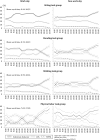Patterns of objectively assessed sedentary time and physical activity among Japanese workers: a cross-sectional observational study
- PMID: 30804025
- PMCID: PMC6443067
- DOI: 10.1136/bmjopen-2018-021690
Patterns of objectively assessed sedentary time and physical activity among Japanese workers: a cross-sectional observational study
Abstract
Objectives: To examine patterns of sedentary behaviour and physical activity, among Japanese workers with differing occupational activity types.
Design: A cross-sectional observational study in 2013-2015.
Setting: Two local communities in Japan.
Participants: Full-time workers aged 40-64 years (n=345; 55% men) and who lived in two cities.
Main outcome measures: From accelerometer data for 7 days, mean overall sedentary time, prolonged bouts of sedentary time and light-and moderate-to vigorous-intensity of physical activity (LPA and MVPA) as a proportion of accelerometer wear time and number of breaks per sedentary hour were identified for four time periods: working hours, workdays, non-work hours and non-workdays. These sedentary behaviour and physical activity measures in the four time periods were examined among workers with four self-attributed occupational activity types (mainly sitting, standing, walking, and physical labour), adjusting for sociodemographic attributes. Diurnal patterns of sedentary behaviour, LPA, and MVPA were examined.
Results: In working hours, those with a sitting job had significantly more total and prolonged sedentary time (total: p<0.001; prolonged: p<0.01) along with less LPA (p<0.001) and MVPA (p<0.001) and less frequent breaks (p<0.01), compared with those with the three more active job type. Similar differences by job type were found for the whole working day, but not for prolonged sedentary time and breaks. On non-working hours and days, differences in sedentary and physically active patterns by job type were not apparent.
Conclusions: Occupational activity type is related to overall sedentary time and patterns on working days, but not to leisure-time sitting and activity patterns, which were similar across the sitting, standing, walking, and physical labour occupational activity types.
Keywords: Asia; descriptive epidemiology; occupational activity patterns; occupational sitting.
© Author(s) (or their employer(s)) 2019. Re-use permitted under CC BY-NC. No commercial re-use. See rights and permissions. Published by BMJ.
Conflict of interest statement
Competing interests: None declared.
Figures
References
Publication types
MeSH terms
LinkOut - more resources
Full Text Sources
Medical
Miscellaneous

